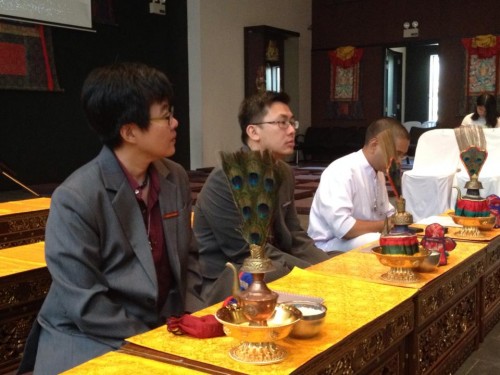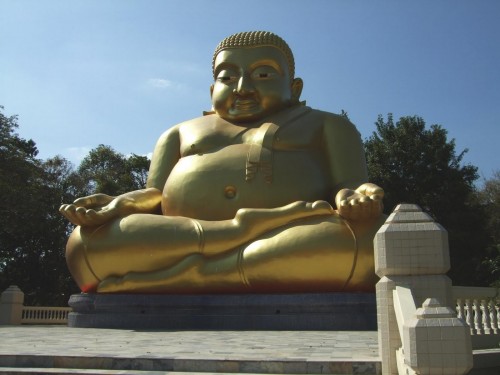The Corpulent Monk
14 May
Happy belated Wesak guys!
In Malaysia, we celebrate Wesak Day yesterday and this is the sacred day of the Buddha’s birth, enlightenment and parinirvana as many of you might already know. It is indeed a sacred day for us Buddhist and so, I was busy the entire day performing my Pastors’ duty to blessed children with Manjushri’s mantra, officiate Rinpoche’s latest book (Un)expected and also Time to Wake Up and was also the puja lead for the prayers at Kechara House. That’s me above with Pastor Lance and Pastor Niral. This is the first time for the 3 of us Pastors to perform the baby blessing.
Anyway, I thought I would give you guys a treat to commemorate this special day – a little story and explanation of Phra Sangkachai or Maha Kaccayana.
According to archaeology, the oldest statuette of the fat monk was found in Asia was dated around the beginning of the Christian era. It was found in Vaisali of India. The image is 4.4 inches high, 2.3 inches wide and0.9inches thick. This Fat monk is depicted in sitting posture with a back slab behind him. At the back of the slab behind the image there was an ancient script in Brahmi and the line can be translated as Saccakaparlbajaka (ji) na.
Saccakaparibajaka was a Nigrantha Jain ascetic. He lived in Vaisali during the lifetime of the Buddha. He possesses immense wealth since birth and later became a philosopher and teacher. He has many followers seeking wealth. Due to his immense wealth and abundance of food and grains, he looked after the poor orphaned children of Vaisali. He was said to have challenged Mahavira and the Buddha to a discussion with him about whose philosophy was the best. At the end of the debate he had to bow down to Buddha and acknowledge the Buddha’s superior wisdom.
Even after he became ordained in the Buddhist monastic order, his fame of being the harbinger of extreme wealth and abundance made him followed by too many worshipers, both Buddhists and non-Buddhists. It was to the point where his popularity was annoyed and jealous by much of Buddha’s other follower monks. To compensate the tension among his monks, Buddha had to explain about the origin of FatMonk Saccaka’s immense wealth and popularity by telling a story of his previous life. 25 worlds ago, at the period of Kaukaukthan Buddha, there was a big flood and his native country was flooded. Many people were starved. The hungry and starved people called Kaukaukthan Buddha for help. Even though he can make food for people with his own powers, Kaukaukthan Buddha asked for help from the people who could donate food for the poor instead. Saccaka at that time was a great merchant and as being a devoted follower, he donated 500 ox-carts full of grains for the hungry people. Therefore the Kaukaukthan Buddha had granted him a promise that he will be extremely rich and abundant for number of lives equal to the number of grains in his 500 ox-carts and his wealth would be immense and uncountable like the number of grains that he had donated for the people. Since that time for 25 worlds, he was always immensely wealthy and abundant in each and every of his life.
Lord Buddha had praised the Fat Monk Saccaka for his excellence in explaining sophisticated dhamma in an easily and correctly understandable manner. The Fat Monk Saccaka also composed the Madhupinadika Sutra or the first Pali Grammar.
One tale relates that when he was young, he was so handsome that once even a man wanted him for a wife. To avoid a similar situation, the Monk Saccaka decided to transform himself into a fat monk. Another tale says he was so attractive that angels and men often compared him with the Lord Buddha. He considered this inappropriate, so began to eat and became very fat so people would not be inappropriately attracted. He obviously just wanted people to come to him for the Dharma and not for other inappropriate reasons.
Since his wealth and abundance is mainly on food and grains, many farmers in Asia regard him as the Lord of the Abundant Grains. Every year, at the start of the rainy season, before starting the farming, his image was taken to the paddy fields and worshipped with flowers, food and water. Then farmers pray at his statue for great yield of paddy for the year.







Thanks for sharing this story David. Very interesting. I enjoy reading stories set during the time of the previous Buddhas (that we know of)
I enjoyed reading this post. You did great during the rituals although that it was your first time.
Thanks alot for sharing this story had a chance to get more knowledge about it …